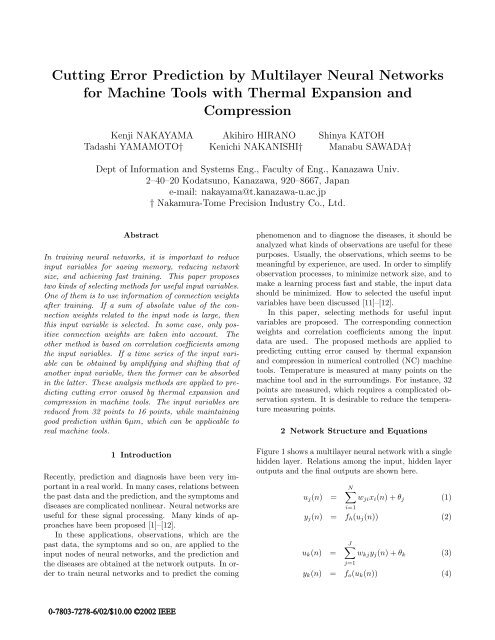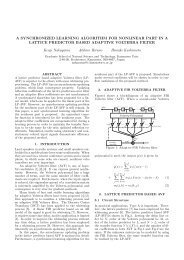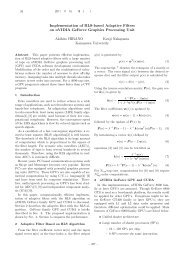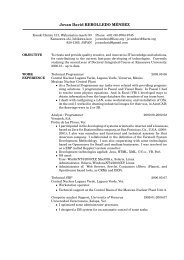Cutting Error Prediction by Multilayer Neural Networks for Machine ...
Cutting Error Prediction by Multilayer Neural Networks for Machine ...
Cutting Error Prediction by Multilayer Neural Networks for Machine ...
Create successful ePaper yourself
Turn your PDF publications into a flip-book with our unique Google optimized e-Paper software.
<strong>Cutting</strong> <strong>Error</strong> <strong>Prediction</strong> <strong>by</strong> <strong>Multilayer</strong> <strong>Neural</strong> <strong>Networks</strong><br />
<strong>for</strong> <strong>Machine</strong> Tools with Thermal Expansion and<br />
Compression<br />
Kenji NAKAYAMA Akihiro HIRANO Shinya KATOH<br />
Tadashi YAMAMOTO† Kenichi NAKANISHI† Manabu SAWADA†<br />
Dept of In<strong>for</strong>mation and Systems Eng., Faculty of Eng., Kanazawa Univ.<br />
2–40–20 Kodatsuno, Kanazawa, 920–8667, Japan<br />
e-mail: nakayama@t.kanazawa-u.ac.jp<br />
† Nakamura-Tome Precision Industry Co., Ltd.<br />
Abstract<br />
In training neural networks, it is important to reduce<br />
input variables <strong>for</strong> saving memory, reducing network<br />
size, and achieving fast training. This paper proposes<br />
two kinds of selecting methods <strong>for</strong> useful input variables.<br />
One of them is to use in<strong>for</strong>mation of connection weights<br />
after training. If a sum of absolute value of the connection<br />
weights related to the input node is large, then<br />
this input variable is selected. In some case, only positive<br />
connection weights are taken into account. The<br />
other method is based on correlation coefficients among<br />
the input variables. If a time series of the input variable<br />
can be obtained <strong>by</strong> amplifying and shifting that of<br />
another input variable, then the <strong>for</strong>mer can be absorbed<br />
in the latter. These analysis methods are applied to predicting<br />
cutting error caused <strong>by</strong> thermal expansion and<br />
compression in machine tools. The input variables are<br />
reduced from 32 points to 16 points, while maintaining<br />
good prediction within 6µm, which can be applicable to<br />
real machine tools.<br />
1 Introduction<br />
Recently, prediction and diagnosis have been very important<br />
in a real world. In many cases, relations between<br />
the past data and the prediction, and the symptoms and<br />
diseases are complicated nonlinear. <strong>Neural</strong> networks are<br />
useful <strong>for</strong> these signal processing. Many kinds of approaches<br />
have been proposed [1]–[12].<br />
In these applications, observations, which are the<br />
past data, the symptoms and so on, are applied to the<br />
input nodes of neural networks, and the prediction and<br />
the diseases are obtained at the network outputs. In order<br />
to train neural networks and to predict the coming<br />
phenomenon and to diagnose the diseases, it should be<br />
analyzed what kinds of observations are useful <strong>for</strong> these<br />
purposes. Usually, the observations, which seems to be<br />
meaningful <strong>by</strong> experience, are used. In order to simplify<br />
observation processes, to minimize network size, and to<br />
make a learning process fast and stable, the input data<br />
should be minimized. How to selected the useful input<br />
variables have been discussed [11]–[12].<br />
In this paper, selecting methods <strong>for</strong> useful input<br />
variables are proposed. The corresponding connection<br />
weights and correlation coefficients among the input<br />
data are used. The proposed methods are applied to<br />
predicting cutting error caused <strong>by</strong> thermal expansion<br />
and compression in numerical controlled (NC) machine<br />
tools. Temperature is measured at many points on the<br />
machine tool and in the surroundings. For instance, 32<br />
points are measured, which requires a complicated observation<br />
system. It is desirable to reduce the temperature<br />
measuring points.<br />
2 Network Structure and Equations<br />
Figure 1shows a multilayer neural network with a single<br />
hidden layer. Relations among the input, hidden layer<br />
outputs and the final outputs are shown here.<br />
u j (n) =<br />
N∑<br />
w ji x i (n)+θ j (1)<br />
i=1<br />
y j (n) = f h (u j (n)) (2)<br />
u k (n) =<br />
J∑<br />
w kj y j (n)+θ k (3)<br />
j=1<br />
y k (n) = f o (u k (n)) (4)<br />
0-7803-7278-6/02/$10.00 ©2002 IEEE
x 1(n)<br />
wj i<br />
w k j<br />
the important input variables are selected <strong>by</strong> using a<br />
sum of the corresponding connection weights after the<br />
training.<br />
y (n) k<br />
J∑<br />
S i,abso = |w ji | (12)<br />
j=1<br />
x N(n)<br />
Input layer<br />
+1<br />
θj<br />
y j<br />
Hidden layer<br />
(n)<br />
θk<br />
Output layer<br />
Figure 1: <strong>Multilayer</strong> neural network with a single hidden<br />
layer.<br />
f h () and f o () are sigmoid functions. The connection<br />
weights are trained through supervised learning algorithms,<br />
such as an error back-propagation algorithm.<br />
3.2 Method-Ib: Based on Positive Connection<br />
Weights<br />
When the input data always take positive numbers, negative<br />
connection weights may reduce the input potential<br />
u j (n) in Eq.(1). Furthermore, when a sigmoid function<br />
shown in Fig.2 is used <strong>for</strong> an activation function, negative<br />
u j (n) generates small output, which does not affect<br />
the final output. Thus, in this case, the negative connection<br />
weights are not useful. There<strong>for</strong>e, only positive<br />
connection weights are taken into account. The useful<br />
temperatures are selected based on S i,posi .<br />
S i,posi = ∑ σ<br />
w σi , w σi > 0 (13)<br />
3 Analysis Methods <strong>for</strong> Useful Input Data<br />
3.1 Method-Ia: Based on Absolute Value of<br />
Connection Weights<br />
The connection weights are updated following the error<br />
back-propagation (BP) algorithm. f˙<br />
o () and f ˙ h () are the<br />
1st order derivative of f o () and f h (), respectively.<br />
w kj (n +1) = w kj (n)+∆w kj (n) (5)<br />
∆w kj (n) = α∆w kj (n − 1)+ηδ k y j (n) (6)<br />
δ k = e k (n) f ˙ o (u k (n)) (7)<br />
e k (n) = d k (n) − y k (n), d k (n) is a target.(8)<br />
w ji (n +1) = w ji (n)+∆w ji (n) (9)<br />
∆w ji (n) = α∆w ji (n − 1)+ηδ j x i (n) (10)<br />
δ j = f ˙<br />
K∑<br />
h (u j (n)) δ k w kj (n) (11)<br />
k=1<br />
From the above equations, the connection weight w ji (n)<br />
is updated <strong>by</strong> ηδ j x i (n). Since η is usually a positive<br />
small number, then <strong>by</strong> repeating the updating, ηδ j x i (n)<br />
is accumulated in w ji (n+1). Thus, growth of w ji (n+1)<br />
is expressed <strong>by</strong> E[δ j x i (n)], which is a cross-correlation.<br />
On the other hand, as shown in Eq.(11), δ j expresses<br />
the output error caused <strong>by</strong> the jth hidden unit output.<br />
If the input variable x i (n) is an important factor, then<br />
it may be closely related to the output error, and their<br />
cross-correlation becomes a large value. For this reason,<br />
it can be expected that the connection weights <strong>for</strong> the<br />
important input variables to the hidden units will be<br />
grown up in a learning process. Based on this analysis,<br />
f (u)<br />
0 u<br />
Figure 2: Sigmoid function, whose output is always positive.<br />
3.3 Method II: Based on Cross-correlation<br />
among Input variables<br />
Dependency among Input variables<br />
First, we discuss using a neuron model shown in Fig.3.<br />
The input potential u is given <strong>by</strong><br />
w1<br />
x1<br />
y = f(u )<br />
w2<br />
x2<br />
u<br />
α<br />
1 (bias)<br />
Figure 3: Neuron model.<br />
u = w 1 x 1 + w 2 x 2 + α (14)<br />
0-7803-7278-6/02/$10.00 ©2002 IEEE
If the following linear dependency is held,<br />
x 2 = ax 1 + b a and b are constant (15)<br />
then, u is rewrriten as follows:<br />
u = w 1 x 1 + w 2 (ax 1 + b)+α (16)<br />
= (w 1 + aw 2 )x 1 +(bw 2 + α) (17)<br />
(18)<br />
There<strong>for</strong>e, <strong>by</strong> replacing w 1 <strong>by</strong> w 1 +aw 2 and α <strong>by</strong> bw 2 +α,<br />
the input variable x 2 can be removed as follows:<br />
u = wx 1 + β (19)<br />
w = w 1 + aw 2 (20)<br />
β = bw 2 + α (21)<br />
This is an idea behind the proposed analysis method.<br />
The linear dependency given <strong>by</strong> Eq.(15) can be analyzed<br />
<strong>by</strong> using correlation coefficients.<br />
Correlation Coefficients<br />
The ith input variable is defined follows:<br />
x i =[x i (0),x i (1), ··· ,x i (L − 1)] T (22)<br />
Correlation coefficient between the ith and the jth variable<br />
vectors is given <strong>by</strong><br />
(x i − ¯x i ) T (x j − ¯x j )<br />
ρ ij =<br />
(23)<br />
‖ x i − ¯x i ‖‖ x j − ¯x j ‖<br />
¯x i,j = 1 L−1<br />
∑<br />
x i,j (n) (24)<br />
L<br />
n=0<br />
If x i and x j satisfy Eq.(15), then ρ ij = 1. In other<br />
words, if ρ ij is close to unity, then x i and x j are linearly<br />
dependent. On the other hand, if ρ ij = 0, then they are<br />
orthogonal to each other.<br />
Combination of Data Sets<br />
The modifications <strong>by</strong> Eqs.(19)–(21) are common in a<br />
MLNN. This means the modifications are the same <strong>for</strong><br />
all the input data sets. Let the number of the data sets<br />
be Q. The input variables are re-defined as follows:<br />
Definition of Input Data <strong>for</strong> Q Data Sets<br />
x (q)<br />
i<br />
= [x (q)<br />
i<br />
(0),x (q)<br />
i<br />
(1), ··· ,x (q)<br />
i<br />
(L − 1)] T (25)<br />
X (q) = [x (q)<br />
1 , x(q) 2 , ··· , x(q)<br />
N<br />
⎡<br />
] (26)<br />
X (1) ⎤<br />
X (2)<br />
X total = ⎢ ⎥<br />
⎣ . ⎦ =[˜x 1, ˜x 2 , ··· , ˜x N ] (27)<br />
˜x i =<br />
⎡<br />
⎢<br />
⎣<br />
X (Q)<br />
x (1)<br />
i<br />
x (2)<br />
ị<br />
.<br />
x (Q)<br />
i<br />
⎤<br />
⎥<br />
⎦<br />
(28)<br />
is the input variable vector of the qth input data set.<br />
X (q) is the qth input data set, X total is a total input<br />
data set, which includes all the input data. In ˜x i , the<br />
ith variables at all sampling points, n =0, 1, ··· ,L− 1<br />
and <strong>for</strong> all data sets q =1, 2, ··· ,Q are included. Using<br />
these notations, the correlation coefficients are defined<br />
as follows:<br />
x (q)<br />
i<br />
ρ ij =<br />
¯˜x i =<br />
(˜x i − ¯˜x i ) T (˜x j − ¯˜x j )<br />
‖ ˜x i − ¯˜x i ‖‖ ˜x j − ¯˜x j ‖<br />
(29)<br />
1<br />
Q∑<br />
L−1<br />
∑<br />
x (q)<br />
i (n)<br />
LQ<br />
(30)<br />
q=1 n=0<br />
One example of the combined input data is shown in<br />
Fig.4, where Q =4.<br />
data set 1 data set 2 data set 3 data set 4<br />
4L<br />
ρij<br />
Figure 4: Combined input variable vectors.<br />
Aberage of Correlation Coefficients<br />
Method-IIa<br />
The correlation coefficients <strong>for</strong> all combinations of the<br />
input variables are calculated <strong>by</strong> Eq.(29). Furthermore,<br />
dependency of the ith variable is evaluated <strong>by</strong><br />
¯ρ (1)<br />
i<br />
¯ρ (1)<br />
i<br />
= 1<br />
N − 1<br />
N∑<br />
ρ ij (31)<br />
j=1<br />
̸=i<br />
expresses average of the correlation coefficients between<br />
the ith variable and all the other variables. Thus,<br />
the variables, which have small ¯ρ i are selected <strong>for</strong> the<br />
useful input variables.<br />
Method-IIb<br />
Let x σ be the selected variable vectors, and the number<br />
of x σ be N 1 . The correlation coefficients ρ (2)<br />
ij are<br />
evaluated once more among the selected σ variable vectors.<br />
The variable vectors are further selected based on<br />
ρ (2)<br />
ij . The variables having large ρ(2) ij are removed from<br />
the selected set. Instead, the variables, which are not<br />
selected in Method-IIa and have small ¯ρ (1)<br />
i<br />
, are selected<br />
and added to x σ . This process is repeated until all the<br />
selected variables have small ρ (2)<br />
ij .<br />
0-7803-7278-6/02/$10.00 ©2002 IEEE
3.4 Comparison with Other Analysis Methods<br />
There are several methods to extract important components<br />
among the input data. One of them is principal<br />
component analysis. The other method is vector<br />
quantization. In these methods, however, in order to<br />
extract these components and vectors, many input data<br />
are required. Our purpose is to simplify the observation<br />
process <strong>for</strong> the input data, that is to select useful input<br />
variables, which are directly observed. It is difficult<br />
to obtain the useful observation data from the principal<br />
components and the representative vectors.<br />
4 <strong>Prediction</strong> of <strong>Cutting</strong> <strong>Error</strong> Caused <strong>by</strong><br />
Thermal Expansion and Compression<br />
Numerical controlled (NC) machine tools are required<br />
to guarantee very high cutting precision, <strong>for</strong> instance<br />
tolerance of cutting error is within 10µm in diameter.<br />
There are many factors, which degrade cutting precision.<br />
Among them, thermal expansion and compression<br />
of machine tools are very sensitive in cutting precision.<br />
In this paper, the multilayer neural network is applied<br />
to predicting cutting error caused <strong>by</strong> thermal effects.<br />
4.1 Structure of NC <strong>Machine</strong> Tool<br />
Figure 5 shows a blockdiagram of NC machine tool.<br />
Distance between the cutting tool and the objective<br />
is changed <strong>by</strong> thermal effects. Temperatures at many<br />
Index<br />
<strong>Cutting</strong> Tool<br />
Frame ( front, back )<br />
z<br />
x<br />
X Axis Slide<br />
dependent on hysteresis of temperature change. x i (n)<br />
means the temperature at the ith measuring point and<br />
at the nth sampling points on the time axis. Its delayed<br />
samples x i (n − 1),x i (n − 2), ··· are generated through<br />
the delay elements ”T” and are applied to the MLNN.<br />
One hidden layer and one output unit are used.<br />
x<br />
x<br />
Delay<br />
x<br />
1(n-1)<br />
1(n-l+1)<br />
1(n)<br />
N(n)<br />
T<br />
T<br />
x<br />
N<br />
x<br />
T<br />
T<br />
(n-l+1)<br />
w<br />
j i<br />
Hidden layer<br />
w<br />
j<br />
y<br />
j (n)<br />
Output layer<br />
e(n)<br />
+<br />
-<br />
y (n)<br />
Figure 6: <strong>Neural</strong> network used <strong>for</strong> predicting cutting error<br />
caused <strong>by</strong> thermal effects.<br />
4.3 Training and Testing Using All Input variables<br />
Four kinds of data sets are measured <strong>by</strong> changing cutting<br />
conditions. They are denoted D 1 ,D 2 ,D 3 ,D 4 . Since<br />
it is not enough to evaluate prediction per<strong>for</strong>mance of<br />
the neural network, data sets are increased <strong>by</strong> combining<br />
the measured data sets <strong>by</strong> linear interpolation, denoted<br />
D 12 ,D 13 ,D 14 ,D 23 ,D 24 ,D 34 . Some of the measured<br />
temperatures in time are shown in Fig.7. Training<br />
and testing conditions are shown in Table 1. All measuring<br />
points are employed. The data sets except <strong>for</strong> D 1<br />
are used <strong>for</strong> training and D 1 is used <strong>for</strong> testing.<br />
Figure 8 shows a learning curve using all data sets,<br />
d(n)<br />
Head Stock<br />
55<br />
Z Axis Slide<br />
Objective<br />
50<br />
Figure 5: Rough sketch of NC machine tool.<br />
points on the machine tool and in surrounding are measured.<br />
The number of measuring points is up to 32<br />
points.<br />
4.2 <strong>Multilayer</strong> <strong>Neural</strong> Network<br />
Figure 6 shows the multilayer neural network used predicting<br />
cutting error of machine tools. The temperature<br />
and deviation are measured as a time series. Thermal<br />
expansion and compression of machine tools are also<br />
Temperature [ C ]<br />
45<br />
40<br />
35<br />
30<br />
25<br />
20<br />
0 5 10 15 20 25 30 35 40 45 50<br />
Time [ min ]<br />
Figure 7: Some of measured temperatures in time.<br />
0-7803-7278-6/02/$10.00 ©2002 IEEE
Table 1: Training and testing conditins<br />
Measuring points<br />
32 points<br />
Training data sets D 2 ,D 3 ,D 4<br />
D 12 ,D 13 ,D 14 ,D 23 ,D 24 ,D 34<br />
Test data set D 1<br />
Learning rate η 0.001<br />
Momentum rate α 0.9<br />
Iterations 100,000<br />
5.1 Selection Based on Connection Weights<br />
The measuring points are selected based on a sum of absolute<br />
value of the connection weights S i,abso (Method-<br />
Ia) and on a sum of positive connection weights S i,posi<br />
(Method-Ib). Figure 10 shows both sums. The horizontal<br />
axis shows the temperature measuring points, that<br />
is 32 points. Their prediction are shown in Fig.11. The<br />
selection method using S i,posi is superior to the other using<br />
S i,abso , because the temperature in this experience<br />
is always positive. The prediction error is within 6µm.<br />
except <strong>for</strong> D 1 , and all measuring points, that is 32<br />
points. The vertical axis means the mean squared error<br />
(MSE) of difference between the measured cutting error<br />
and the predicted cutting error. It is well reduced.<br />
12<br />
10<br />
Sum of Absolute Value<br />
Sum of Positive Value<br />
8<br />
0.002<br />
6<br />
0.0015<br />
4<br />
2<br />
MSE<br />
0.001<br />
0<br />
1 2 3 4 5 6 7 8 9 10 11 12 13 14 15 16 17 18 19 20 21 22 23 24 25 26 27 28 29 30 31 32<br />
0.0005<br />
Figure 10: Sum of absolute value of temperature and positive<br />
temperature.<br />
0<br />
0 10000 20000 30000 40000 50000 60000 70000 80000 90000 100000<br />
iteration<br />
Figure 8: Learning curve of cutting error prediction. All<br />
measuring points are used.<br />
Figure 9 shows cutting error prediction under the conditions<br />
in Table 1. The prediction error is within 6µm,<br />
which satisfies the tolerance 10µm in diameter.<br />
Deviation [ µm ]<br />
8<br />
4<br />
0<br />
-4<br />
-8<br />
-12<br />
-16<br />
Sum of Absolute Value<br />
Sum of Positive Value<br />
Measurement<br />
Deviation [ µm ]<br />
8<br />
4<br />
0<br />
-4<br />
-8<br />
-12<br />
-16<br />
-20<br />
<strong>Prediction</strong><br />
Measurememt<br />
-20<br />
-24<br />
-28<br />
-32<br />
0<br />
250 500 750 1000 1250 1500<br />
Time [ min ]<br />
Figure 11: <strong>Cutting</strong> error prediction with 16 measuring<br />
points selected <strong>by</strong> connection weights.<br />
-24<br />
-28<br />
0<br />
250 500 750 1000 1250 1500<br />
Time [ min ]<br />
Figure 9: <strong>Cutting</strong> error prediction. All measuring points<br />
are used.<br />
5 Selection of Useful Measuring Points<br />
The useful 16 measuring points are selected from 32<br />
points <strong>by</strong> the analysis methods proposed in Sec.3.<br />
5.2 Selection Based on Correlation Coefficients<br />
In Method-IIb, after the first selection <strong>by</strong> Method-IIa,<br />
the variables, whose correlation coefficients ρ (2)<br />
ij exceed<br />
0.9 are replaced <strong>by</strong> the variables, which are not selected<br />
in the first stage and have small ¯ρ (1)<br />
i . Simulation results<br />
<strong>by</strong> both methods are shown in Fig.12. The result<br />
<strong>by</strong> Method-IIb ”Correlation(2)” is superior to that of<br />
Method-IIa ”Correlation(1)”. Because the <strong>for</strong>mer more<br />
precisely evaluates the correlation coefficients.<br />
0-7803-7278-6/02/$10.00 ©2002 IEEE
Deviation [ µm ]<br />
12<br />
8<br />
4<br />
0<br />
-4<br />
-8<br />
-12<br />
-16<br />
-20<br />
-24<br />
-28<br />
0<br />
Correlation (1)<br />
Correlation (2)<br />
Measurement<br />
250 500 750 1000 1250 1500<br />
Time [ min ]<br />
Figure 12: <strong>Cutting</strong> error prediction with 16 measuring<br />
points selected <strong>by</strong> correlation coefficients.<br />
5.3 Comparison of Selected Measuring Points<br />
Table 2 shows the selected temperature measuring<br />
points <strong>by</strong> four kinds of the methods. Comparing the<br />
selected measuring points <strong>by</strong> Method-Ib and Method-<br />
IIb, the following 9 points 4, 11, 12, 14, 15, 21, 22, 28, 31<br />
are common. However, the selected measuring points<br />
are not exactly the same. A combination of the measuring<br />
points seems to be important.<br />
Table 2: Measuring points selected <strong>by</strong> four kinds of methods.<br />
Methods<br />
Measuring points<br />
Method-Ia 2, 3, 6, 7, 9,15,18,19,<br />
Sum of absolute values 21,22,24,25,26,28,30,31<br />
Method-Ib 1, 4, 7, 9, 11,12,13,14,<br />
Sum of positive weights 15,19,21,22,23,26,28,31<br />
Method-IIa 3, 4, 7, 8,12,14,16,18,<br />
Correlation(1) 19,20,21,22,23,25,31,32<br />
Method-IIb 3, 4, 8,11,12,14,15,16,<br />
Correlation(2) 20,21,22,27,28,30,31,32<br />
6 Conclutions<br />
Two kinds of methods, selecting the useful input variables,<br />
have been proposed. They are based on the connection<br />
weights and the correlation coefficients among<br />
the input variables. The proposed methods have been<br />
applied to predicting cutting error caused <strong>by</strong> thermal<br />
effects in machine tools. Simulation results show precise<br />
prediction with the reduced number of the input<br />
variables.<br />
References<br />
[1] S.Haykin, ”<strong>Neural</strong> <strong>Networks</strong>: A Comprehensive<br />
Foundation,” Macmillan, New York, 1994.<br />
[2] S.Haykin and L. Li, ”Nonlinear adaptive prediction<br />
of nonstationary signals,” IEEE Trans. Signal Processing,<br />
vol.43, No.2, pp.526-535, Feburary. 1995.<br />
[3] A. S. Weigend and N. A. Gershenfeld, ”Time series<br />
prediction: Forecasting the future and understanding<br />
the past. in Proc. V. XV, Santa Fe Institute, 1994.<br />
[4] M. Kinouchi and M. Hagiwara, ”Learning temporal<br />
sequences <strong>by</strong> complex neurons with local feedback,”<br />
Proc. ICNN’95, pp.3165-3169, 1995.<br />
[5] T.J. Cholewo and J.M. Zurada, ”Sequential network<br />
construction <strong>for</strong> time series prediction,” in Proc.<br />
ICNN’97, pp.2034-2038, 1997.<br />
[6] A. Atia, N. Talaat, and S. Shaheen, ”An efficient<br />
stock market <strong>for</strong>ecasting model using neural networks,”<br />
in Proc. ICNN’97, pp.2112-2115, 1997.<br />
[7] X.M. Gao, X.Z. Gao, J.M.A. Tanskanen, and S.J.<br />
Ovaska, ”Power prediction in mobile communication<br />
systems using an optimal neural-network structure”,<br />
IEEE Trans. on <strong>Neural</strong> <strong>Networks</strong>, vol.8, No.6, pp.1446-<br />
1455, November 1997.<br />
[8] A.A.M.Khalaf, K.Nakayama, ”A cascade <strong>for</strong>m<br />
predictor of neural and FIR filters and its minimum size<br />
estimation based on nonlinearity analysis of time series”,<br />
IEICE Trans. Fundamental, vol.E81-A, No.3, pp.364–<br />
373, March 1998.<br />
[9] A.A.M.Khalaf, K.Nakayama, ”Time series prediction<br />
using a hybrid model of neural network and FIR<br />
filter”, Proc. of IJCNN’98, Anchorage, Alaska, pp.1975-<br />
1980, May 1998.<br />
[10] A.A.M. Khalaf and K.Nakayama, ”A hybrid nonlinear<br />
predictor: Analysis of learning process and<br />
predictability <strong>for</strong> noisy time series”, IEICE Trans.<br />
Fundamentals,Vol.E82-A, No.8, pp.1420-1427, Aug.<br />
1999.<br />
[11] K.Hara and K.Nakayama, ”Training data selection<br />
method <strong>for</strong> generalization <strong>by</strong> multilayer neural networks”,<br />
IEICE Trans. Fundamentals, Vol.E81-A, No.3,<br />
pp.374-381, March 1998.<br />
[12] K.Hara and K.Nakayama, ”A training data selection<br />
in on-line training <strong>for</strong> multilayer neural networks”,<br />
IEEE–INNS Proc. of IJCNN’98, Anchorage, pp.227-<br />
2252, May 1998.<br />
0-7803-7278-6/02/$10.00 ©2002 IEEE






